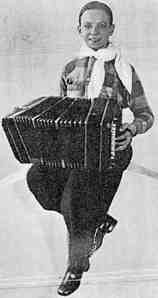
The bandoneon is an instrument which has achieved a great popularity in South America. This is partly due, no doubt, to the fact that it is so suited to the haunting rhythm of tango music. It is not so well-known in the United States, but there are a few bandoneon artists in this country. Among them, despite his youth, is Astor Piazzola.
Fifteen years ago this musician was born in Mar-del-Plata, Buenos Aires. When he was about nine years of age, he came with his parents to New York City, where he has made his home ever since. The Piazzola family, being musically inclined, did not forget the instrument they had heard so frequently in their native land, and as a result, Astor for the past five years has been studying and playing the bandoneon.
There are very few teachers of the bandoneon in New York City. It is much harder to learn than the piano-accordion. It is also rather difficult to secure music for this instrument, as it is printed only in South America. Astor uses piano music, somewhat revised.
The instrument was invented in 1830 in Germany by a man named Uhlig. It is square in shape; has single notes on the bass side and three octaves on the right hand as well as on the bass side. It has 72 keys altogether, 36 on each side. In playing the instrument one uses four fingers on each hand. Bandoneons are all made in Germany. They cost 300 pesos in South America, or about $100. The most famous artist of the bandoneon is Laurenz, who is a native of Argentina.
Young Astor Piazzola has a repertoire which includes such classic numbers as "William Tell" and "Poet and Peasant" overtures. He plays solos in tango orchestras and from time to time broadcasts over short wave station W2XAF, Schenectady to South America.
With this career behind him at the age of fifteen, we predict a brilliant future for this gifted young musician.
The Classical Free-Reed, Inc. gratefully acknowledges accordion historian Stanley Darrow for his kind permission to conduct research at the American Accordion Musicological Society library.
| Invitation to Contributors / Submission Guidelines |
| Back to The Free-Reed Journal Contents Page |
| Back to The Classical Free-Reed, Inc. Home Page |